If you’re preparing for a triathlon, it probably seems like the last thing you need is more exercise. With all those swimming, biking and running workouts packed into your schedule, the only elements you’re tempted to add to your routine may be a cold drink and a long nap.
But by sliding just two 30-minute strength-training workouts into your weekly regimen, you’ll not only make your pending race easier and more enjoyable, you’ll also guard against injury and become a leaner, stronger and more athletic competitor. You might even improve your finish time.
“Triathlon training develops plenty of endurance, but lacks some crucial components for developing muscular strength and balance,” explains Troy Jacobson, director of endurance training for Life Time Fitness and coauthor of Triathlon Anatomy. Typical tri-training programs also underemphasize some muscle groups while overstressing others, he adds. Over time this can lead to functional imbalances — and, ultimately, to pain and injury. Not a great payoff for all your hard work.
The solution? Get stronger.
Just a little bit of resistance training on top of your cardio work can develop the hamstrings, upper back and other areas that are often neglected during endurance training. The resulting strength can help guard against some of the more common triathlon-related overuse injuries in the hips, knees, lower back and shoulders.
More head-to-toe strength and muscle mass will also help you burn fat around the clock — whether you’re on the bike or on the couch. And strength work ensures that you’ll maintain a broad base of fitness even as your training becomes more triathlon-specific.
What you won’t do with these tri-prep workouts is build huge amounts of bulk. “The program isn’t designed to pack on muscular size or weight,” Jacobson says, so there’s no need to worry about extra mass slowing you down. On the contrary, you’ll be building the kind of sleek and shapely physique that puts you across the finish line faster.
Put Some Muscle in Your Race
Jacobson recommends scheduling your strength training around your regular triathlon workouts. If this means you’ll need to do strength and endurance workouts on certain days, make sure you do your endurance or sport-specific training first.
The following plan is designed to start six weeks before your race, so you peak as your race approaches, and involves two lifting sessions — “A” and “B” — on nonconsecutive days.
Warm up with at least five minutes of dynamic stretching, easy jogging, cycling or rowing. Unless otherwise noted, rest 60 to 90 seconds between sets.
The last two weeks before your race, you’ll see that you actually do fewer sets and reps of each move. That’s by design. “The quickest results from any training program come after four to six weeks of consistent training, depending on the individual,” explains Jacobson. “Then you’ll want to deload, or taper down, your strength training so you’re as fresh as possible on race day.”
Workout A
1) Speed Pushups
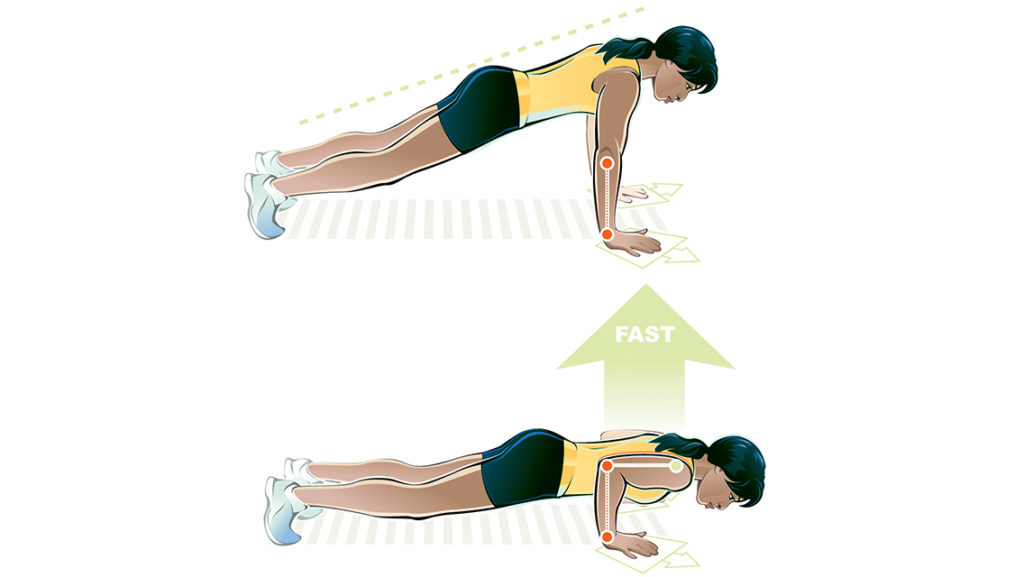
- Assume the standard pushup position: hands slightly wider than shoulder width, balls of feet on the floor, body in a straight line from your heels to the crown of your head.
- Without letting your hips or head sag toward the floor, bend your arms, pull your shoulder blades together, and lower your body, keeping your elbows at about a 45-degree angle to your torso.
- When your chest is a few inches from the floor, quickly push yourself back up to the starting position.
Easier version: Perform the exercise with your hands on an elevated surface like a bench or countertop: the higher the surface, the easier the move.
Harder version: Perform the exercise with your feet elevated.
- Why it’s good for triathletes: Improves upper-body pushing power; useful for the swim start and steep climbing on the bike.
Sets and Reps
- Week One: two sets of as many reps as possible in 20 seconds
- Week Two: three sets of as many reps as possible in 20 seconds
- Weeks Three and Four: three sets of as many reps as possible in 30 seconds
- Weeks Five and Six: two sets of as many reps as possible in 20 seconds; slow down these weeks and focus on perfect form.
2) Chin-Ups

- Take an underhand, shoulder-width grip on a chin-up bar with your palms facing toward you.
- Lift your feet from the floor and allow your arms to straighten fully.
- Pull your shoulder blades down and back, bend your arms, and pull yourself up until your chin is slightly above the bar.
- Lower yourself slowly back to the starting position.
Easier version: Perform the same exercise using an assisted chin-up machine, or have a partner give you a boost as you perform the move.
Harder version: If you can bang out 12 to 15 reps of body-weight chin-ups with no problem, try the same exercise while squeezing a dumbbell between your legs.
- Why it’s good for triathletes: Develops the upper-back musculature necessary for a strong swimming stroke and for maintaining good posture throughout the run.
Sets and Reps
- Week One: two sets of 12 reps
- Week Two: two sets of 15 reps
- Weeks Three and Four: three sets of 12 to 15 reps
- Weeks Five and Six: one or two sets of 10 reps
3) Alternating Dynamic Lunges

- Stand with feet shoulder-width apart, then step your left foot forward about a stride-and-a-half, allowing the heel of your right foot to lift an inch or two off the floor.
- Keeping your back straight and your eyes looking ahead, slowly bend both legs until your right knee lightly touches the floor.
- Reverse the movement, stepping your left foot back, and return to the starting position.
- Repeat on the opposite side. That’s one rep.
Easier Version: Lower your back knee only halfway down to the floor on each rep before coming back up.
Harder Version: Hold dumbbells at your sides.
- Why it’s good for triathletes: Keeps the hip flexors limber and develops the glutes, helping to prevent lower-back pain and injury that can sometimes result from too much time in the saddle.
Sets and Reps
- Week One: three sets of 12 reps
- Week Two: three sets of 15 reps
- Weeks Three and Four: three sets of 12 to 15 reps
- Weeks Five and Six: two sets of 12 reps
4) Stability-Ball Speed “Olympic Diver” Crunches
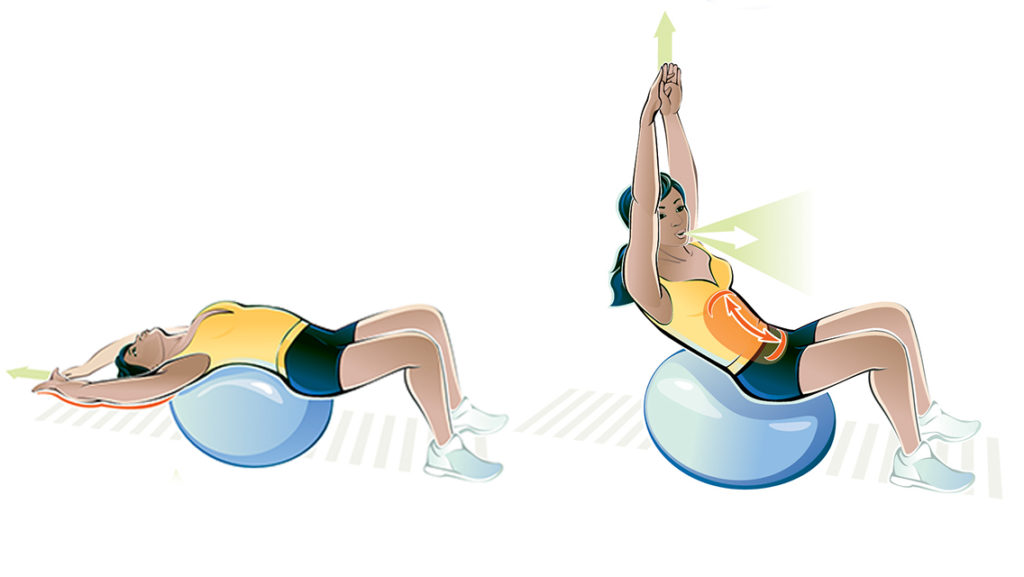
- Sit on a stability ball, walk your feet forward, and lie back on the ball until your torso is parallel to the floor.
- Extend your arms overhead, interlace your fingers, and squeeze your upper arms close to your ears.
- Keeping your arms in this position, blow out forcefully, contract your abdominal muscles, and squeeze the bottom of your rib cage toward your pelvis.
- Return to horizontal position.
Easier Version: Perform the movement sitting toward the front of the ball so the ball supports your back, and your hands are higher than your knees in the starting position.
Harder Version: Hold a light dumbbell in your hands.
- Why it’s good for triathletes: Unlike conventional crunches, this stricter version keeps your spine long as you work the core, which translates into better form on the run and a more streamlined shape in the water.
Sets and Reps
- Week One: two sets of as many as possible in 20 seconds
- Week Two: two sets of as many as possible in 30 seconds
- Weeks Three and Four: three sets of as many as possible in 30 seconds
- Weeks Five and Six: two sets of 12 to 15 reps, focusing on form
Workout B
1) Stability-Ball Dumbbell Overhead Presses
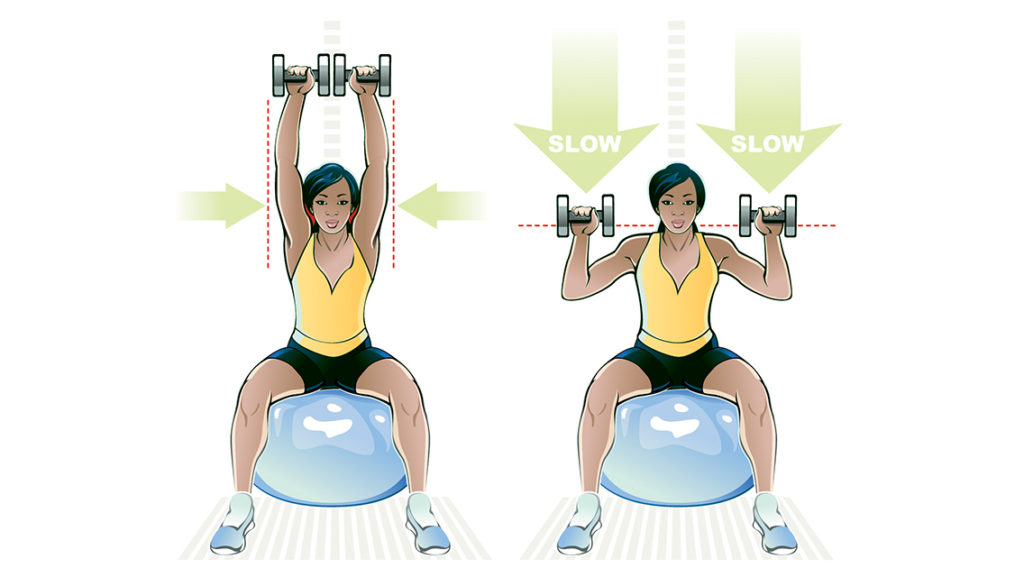
- Sit upright on a stability ball, holding two moderately heavy dumbbells at shoulder height, palms roughly parallel.
- Keeping your lower back in its natural arch, smoothly press the dumbbells upward until your arms are fully extended overhead and your upper arms are close to your ears.
- Slowly reverse the movement and repeat for the appropriate reps.
Easier Version/Harder Version: Adjust the weight accordingly.
- Why it’s good for triathletes: Improves shoulder stability and strength — both invaluable during the swim and bike stages.
Sets and Reps
- Week One: two sets of 12 reps
- Week Two: two sets of 15 reps
- Weeks Three and Four: three sets of 15 reps
- Weeks Five and Six: two sets of 12 reps
2) Seated Cable Rows
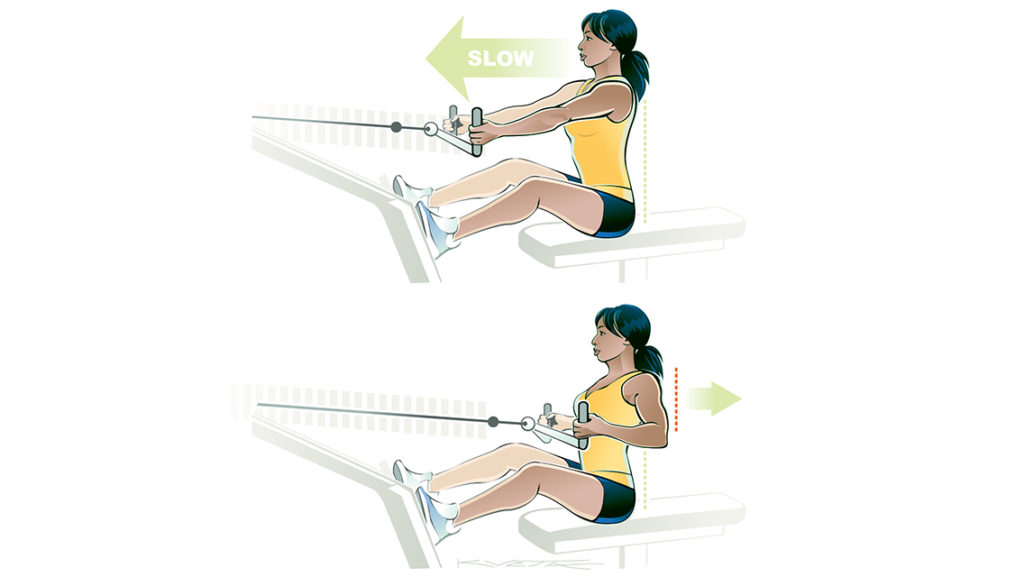
- Attach a parallel-grip handle to the low pulley cable at a seated row station and set the pin at a moderately heavy weight.
- Sit on the seat, place your feet against the platform, and take hold of the handles.
- Sit up straight, arching your lower back and lifting your chest slightly.
- Without allowing your head to push forward, bend your arms and strongly retract your shoulder blades, pulling the handle back until it nearly touches your abdomen.
- Slowly extend your arms and return to the starting position.
Easier Version/Harder Version: Adjust the resistance accordingly.
- Why it’s good for triathletes: Protects against “swimmer’s shoulder” and other issues caused by overuse of the shoulder joint.
Sets and Reps
- Week One: two sets of 12 reps
- Week Two: two sets of 15 reps
- Weeks Three and Four: three sets of 15 reps
- Weeks Five and Six: two sets of 12 reps
3) Dumbbell Front Squats
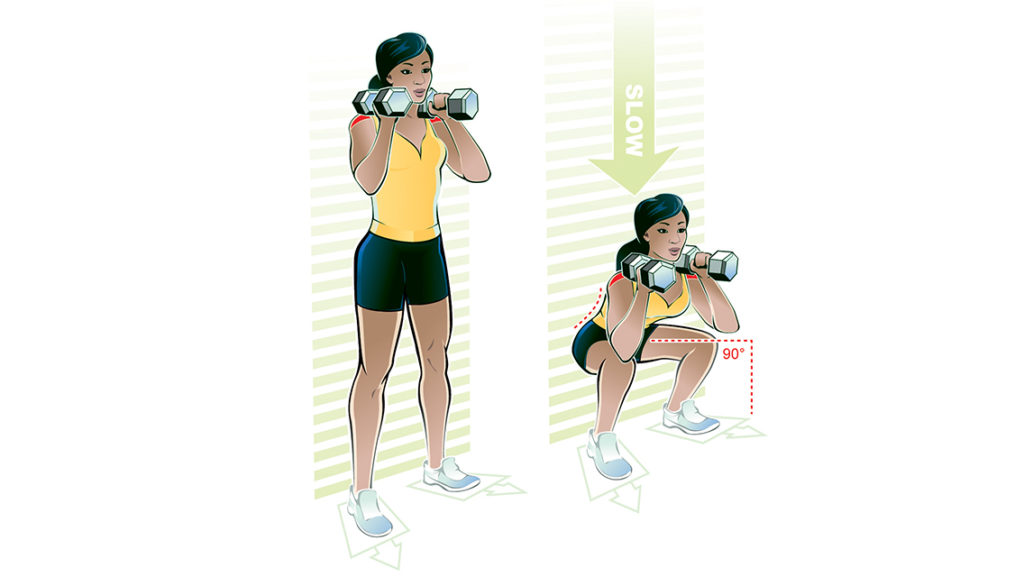
- Holding two moderately heavy dumbbells, stand with your feet slightly wider than shoulder width and your toes pointed slightly outward.
- Lift the dumbbells to shoulder height and rest them on the fronts of your shoulders throughout the movement.
- Keeping your feet flat on the floor, your eyes looking ahead and your lower back in its natural arch, slowly squat down until your thighs are at least parallel to the floor.
- With your weight on your heels, return to standing, keeping your chest up throughout the exercise.
Easier Version: Use body weight only, and, if necessary, only squat halfway down.
Harder Version: Use heavier dumbbells and squat as deeply as you can while keeping your lower back in its natural arch.
- Why it’s good for triathletes: Builds strength in the lower body — especially useful for sprinting and climbing during the bike and the run.
Sets and Reps
- Week One: two sets of 12 reps
- Week Two: two sets of 15 reps
- Weeks Three and Four: three sets of 15 reps
- Weeks Five and Six: two sets of 12 reps
4) Knee-Ups
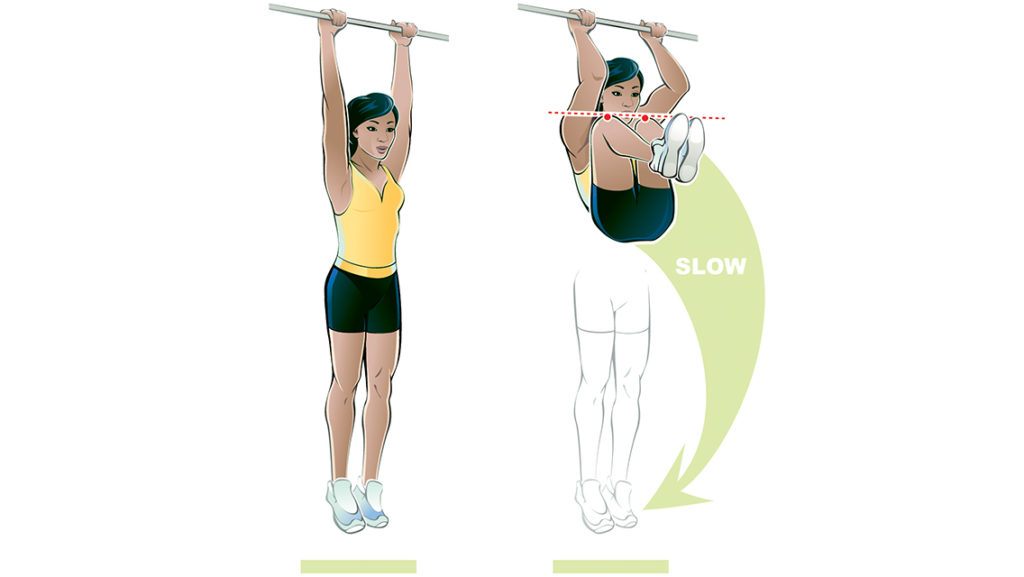
- Take an overhand, shoulder-width grip on a chin-up bar, palms facing away from you, allowing your legs to hang straight down toward the floor.
- Keeping your feet together, lift your knees as high as possible.
- Pause for a moment in the contracted position, slowly lower your knees back to the starting position, and repeat for the appropriate number of reps.
Easier Version: Perform the same movement using a pair of slings, which attach to a chin-up bar and loop around your upper arms so you don’t have to grip the bar. Then lift your knees just halfway up.
Harder Version: Perform the same movement with your legs straight, touching your toes to the bar.
- Why it’s good for triathletes: Improves hip mobility, hip-flexor strength and core stability, for better strength and more efficient positioning during the run.
Sets and Reps
- Week One: two sets of 12 reps
- Week Two: two sets of 15 reps
- Weeks Three and Four: three sets of 15 reps
- Weeks Five and Six: two sets of 12 reps
This article originally appeared as “Triathlon Strong in 6 Weeks” in the May 2013 issue of Experience Life.
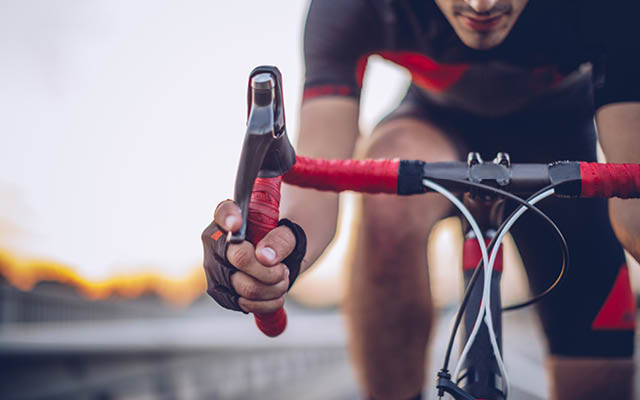
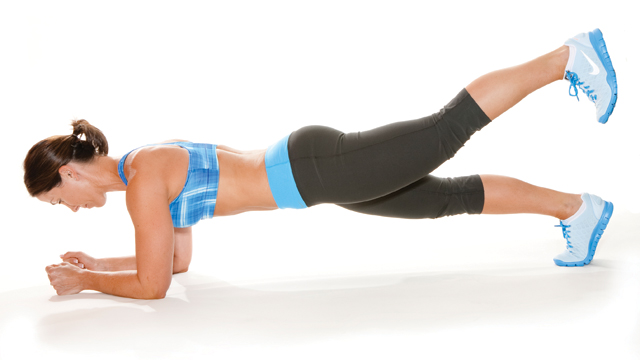
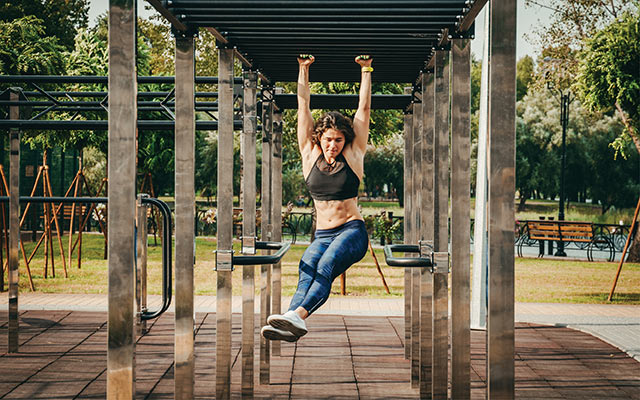

This Post Has 0 Comments